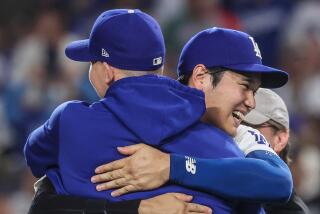World Perspective : OKINAWA : The Final Campaign
- Share via
As 182,000 U.S. assault troops started ashore, World War II’s last big battle began 50 years ago today. The Japanese worked a year, creating 60 miles of underground positions-enough to shelter all 100, 000 defenders. their strategy: a defensive battle to delay U.S. takeover of this key staging point to the Japanese mainland.
‘Blowtorch and Corkscrew’
A hallmark of fighting on Okinawa was attacks on caves and fortified positions that honeycombed the hills, escarpments and terraces. Americans assaulted many of these positions using a method known as “blowtorch (flammables) and corkscrew (explosives).” Some scenarios:
1. Support team uses automatic-weapons fire to suppress defenders, allowing flamethrower team to approach.
2. Flamethrower, supported by two riflemen, directs flame into cave, causing suffocation, burns.
3. Demolition man tosses in satchel charge of explosives, sometimes sealing cave.
4. Gasoline, grenade dropped down vent.
What Made Okinawa Different
Kamikaze attacks: Suicide pilots in 1,465 planes filled with explosives took a huge toll, sinking 26 ships, damaging 164 and killing more than 3,000 sailors. Name means “divine wind,” after typhoon that destroyed Mongol fleet invading Japan in 1281.
Naval losses: This was the costliest battle in Navy history: 32 ships sunk, 368 damaged and nearly 10,000 casualties. One measure of the ferocity of the campaign is that more Navy men were killed than wounded-a highly unusual situation.
Fallen leaders: Neither commander survived the battle, the only time this happened in the Pacific war. Lt. Gen. Simon Bolivar Buckner Jr. was killed in action June 18. Four days later, his counterpart, Lt. Gen. Mitsuru Ushijima, committed suicide.
Correspondent killed: Probably the most famous casualty was Pulitzer-winning columnist Ernie Pyle, whose writing endeared him to ordinary soldiers. He was killed April 18 on le Shima, a nearby island, during fighting coincident with that on Okinawa.
Okinawan culture: Ethnic mixture of Chinese, Malays and Ainus. Once independent, the islanders were absorbed into Japanese empire in 1870s. Fighting in 1945 virtually destroyed the island. Estimates of civilians killed: 42,000 to 150.000.
Wounded care: 2.8% of American wounded died, a mortality rate half that of other Pacific battles and comparable to that in Europe. U.S. used 15,000 gallons of whole blood. Cave conditions, lack of equipment and drugs left Japanese wounded little chance.
Okinawa’s Price
Okinawa produced more American casualties than any Pacific campaign. How it compares to four other costly battles (American figures include killed and wounded; for Japanese, who customarily fought to the death, figures are for killed.):
Battle: Tarawa*
Duration (days): 3
Area (square miles): 1/2
Distance to Japan (miles): 3,200
Casualties (American): 3,019
Casualties (Japanese): 4,500
*
Battle: Peleliu
Duration (days): 72
Area (square miles): 5
Distance to Japan (miles): 1,650
Casualties (American): 10,021
Casualties (Japanese): 10,500
*
Battle: Saipan
Duration (days): 25
Area (square miles): 48
Distance to Japan (miles): 1,500
Casualties (American): 16,525
Casualties (Japanese): 30,000
*
Battle: Iwo Jima
Duration (days): 36
Area (square miles): 8
Distance to Japan (miles): 750
Casualties (American): 26,038
Casualties (Japanese): 21,000
*
Battle: Okinawa
Duration (days): 82
Area (square miles): 485
Distance to Japan (miles): 350
Casualties (American): 49,151
Casualties (Japanese): 90,000**
* Betio only
** Includes approximately 20,000 Okinawan conscripts
Defense in Depth
Japanese defenders used direct fire and mutually supporting reverse-slope positions. Combined with interconnecting tunnels, this made it possible for Americans to be atop a hill, yet not control it:
Attacking U.S. troops
Japanese defensive positions
Path of Battle
After Americans landed, some turned north and by April 20 controlled entire northern part of island. After reaching east coast, remainder wheeled south and by April 5 had met the main defenses. Not until June 21 was Okinawa declared secure.
Perimeter of Japanese stronghold:
April 1: Invasion forces land
April 1-2: Fake invasion distracts defenders
June 21: Japanese defeated
Tongues of Fire: Flamethrowing tanks, covered by infantry to prevent suicide attacks, were a vastly more dangerous and feared weapon than the version carried on the backs of soldiers:
Hand-Held Tank Fuel capacity 4 gallons 290 gallons Firing time 5-10-sec. bursts up to 2.5 min. Range 40 yards 60-80 yards
Sources: “Okinawa: Typhoon of Steel,” “Victor in the Pacific,” “History of U.S. Marine Corps Operations in World War II,” “Okinawa: Victory in the Pacific”; Researched by TOM REINKEN / Los Angeles Times
More to Read
Sign up for Essential California
The most important California stories and recommendations in your inbox every morning.
You may occasionally receive promotional content from the Los Angeles Times.













